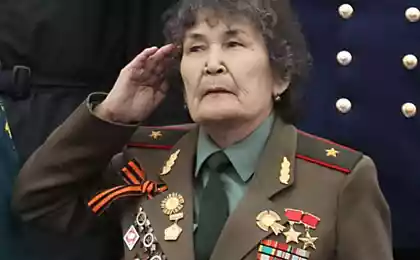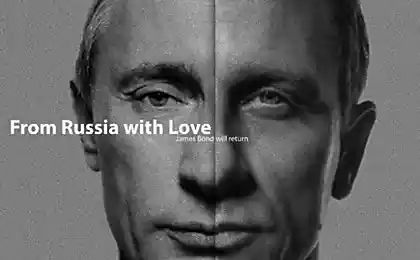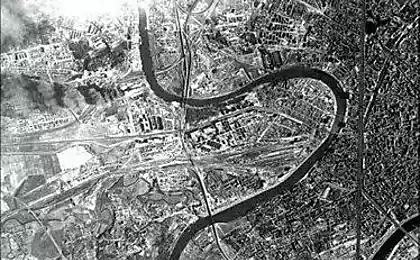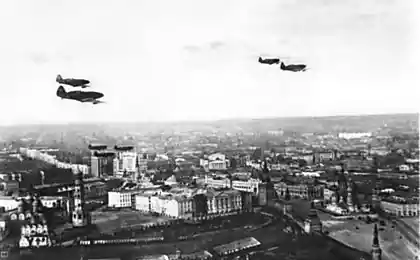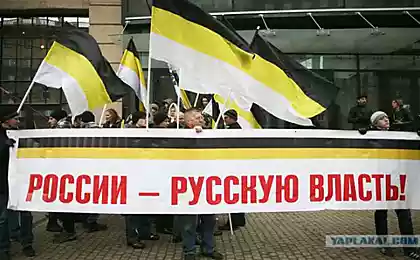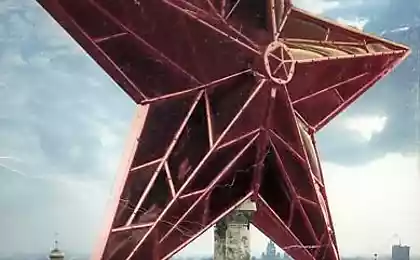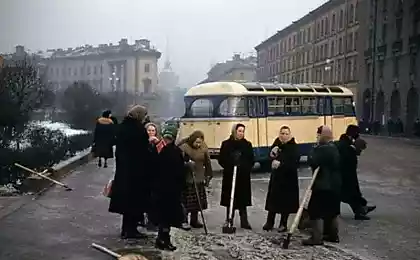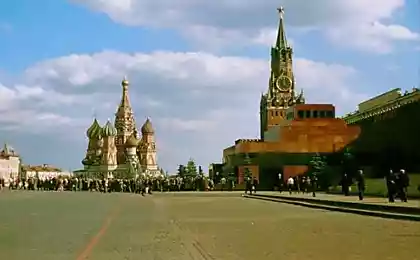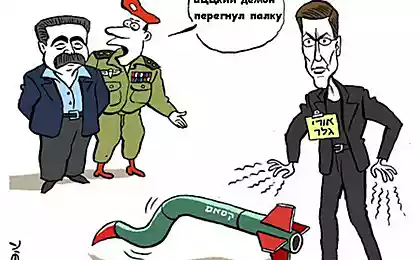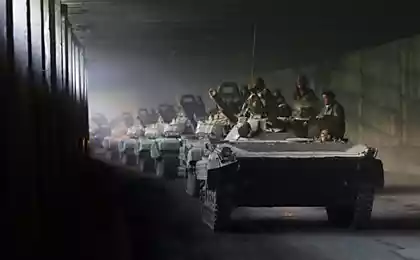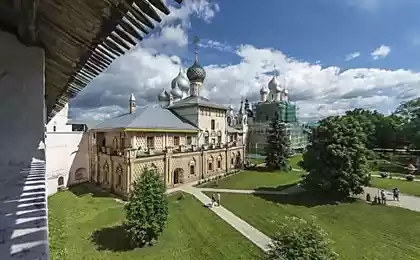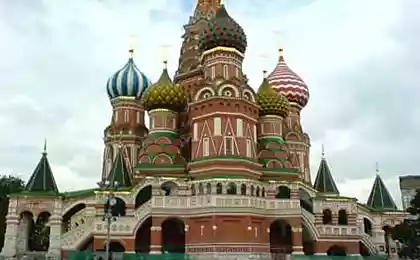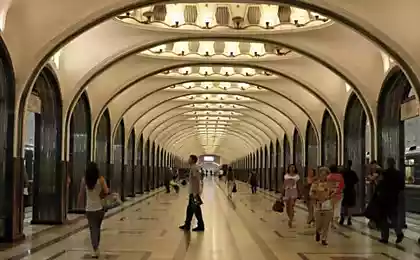1346
Masking Kremlin
Fantastic plan
The Germans invaded the Soviet state on June 22. It was clear that very soon the clouds of enemy bombers to take off to Moscow, but because by the middle of July, Moscow was surrounded by a dense ring of defense and led the embattled aircraft. Despite this, the command understood that 100 percent against air attack will fail: some aircraft still break through to the capital. Prepared to protect the public bomb shelters, provided blackout buildings and transport. But what about the important strategic objects, plants, architectural monuments, as well as the Mausoleum and the Kremlin - a symbol of the country? How to prevent their destruction?
Exit found a group of architects led by Boris Mikhailovich Iofana. He suggested that simply mask the Kremlin, the surrounding area, and the rest of the most valuable objects. The project at the time looked fantastic! But there was no time to reflect - the troops of Army Group "Center" rushed to Moscow, and the command had to agree. The archive remained secret memo dated 26 June 1941, in which the Kremlin commandant, Major-General Nikolai Spiridonov recommends Laurentia Beria immediately implement the plan Boris Iofana.
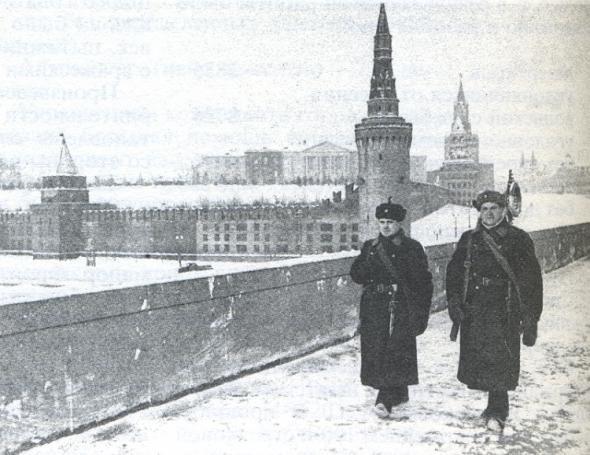
Walls and towers disguised as homes
Moscow does not Zlatoglavaya
Talking about the disguise of the Kremlin, could not help remembering an old anecdote: "As long as the enemy is developing a strategy offensive, Soviet soldiers manually alter the landscape and thus introduced the enemy into confusion." This is what our soldiers do. Drafting group Iofana completed by July 14. Offers two versions of the "disappearance" of the Kremlin: plane and false disguise. The first involves repainting buildings and hide their most noticeable elements. Muscovites immediately went to work: all the old buildings stylized as ordinary houses, painted over green roofs, caused the dark paint on the gilded domes, crosses removed, sheathed stars on the towers. On the Kremlin walls painted windows and doors, and teeth covered with plywood, imitated rooftops. All this is carried out by specially selected from each shelf unit. At the highest buildings such as Ivan the Great Bell worked climbers. During repainting particularly important and valuable structures necessarily present architects.
In the second variant masking needed using false objects unrecognizable to change the layout of the Moscow streets. Throughout Moscow, and especially in the vicinity of the Kremlin, the building appeared ghost who "built up" all the squares and parks. Silhouettes of many structures have changed scrim. Everywhere stretched to not existing roads, but the real painted so as to be visible from above "roofs". So from the air looked, and Red Square. And across the Moscow River bridge spread false.
By the way, despite the fact that the mausoleum became too "ordinary city building" - it has grown over the plywood two-storey house - to completely destroy the resting place of Lenin, it was enough to hit a bomb. And because July 3, Lenin's body was sent by special train to Tyumen. Back Ilyich returned only 28 March 1945.
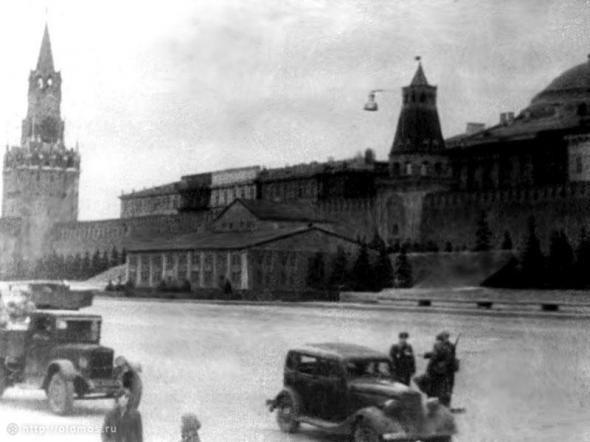
BM Lofan. His plan masking saved Moscow from destruction

The first raid
Finish to disguise the bombing did not have time. The first attack occurred on the night of 21 July 22 - exactly one month after the war began. Around 10 pm 220 Luftwaffe (German Air Force) appeared from Smolensk. Piloted their professional pilots gain experience breaking through the defense even during the bombing of cities in Western Europe. However, to get through to Moscow was much more difficult - through Soviet antiaircraft barrier managed to get only a few machines. The fact that the disguise worked, says such a fact: the territory of the Kremlin dropped a few bombs, and do not cause serious damage. Only one 250-pound bomb landed in the Grand Kremlin Palace - the bomb pierced the roof and the ceiling of St. George Hall, hit the floor, but did not explode. All in all, in Moscow during this five-hour raid 37 buildings collapsed.
Convinced of the effectiveness of the plan Iofana, command tried as quickly as possible to complete the disguise. Already on July 29 MGB Major NS Bacon soared over Moscow by plane "Douglas" and inspection activities from a height of a thousand meters, was pleased with the result.
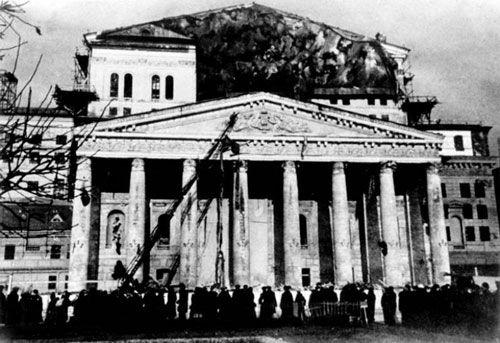
Blind-Fight
Starting from July 22, the bombing became regular. Nazi planes appeared over Moscow, barely dusk falls, and bombed until five or six o'clock in the morning. Sometimes overnight happened four or five raids. Due to the powerful defense Germans did not dare to attack the daytime, and at night "rebuilt" Moscow shoot them down completely confused. Bombers usually move in two waves: the first threw firebombs, and the second - explosive, aiming at the first object illuminated. It is clear that with such a sight difficult to determine where the real purpose, and where not. Of course, the pilots have adapted to distinguish some dummies (for example, painted houses, as opposed to the real, do not cast shadows). But stray flares specifically established for this small-caliber anti-aircraft guns and machine guns, blinded pilot beams of searchlights, had to dive under heavy anti-aircraft fire, which made air attacks even harder. So most of the bombs were dropped randomly, and many sights strikes by "ghosts." For example, some false objects Muscovites specifically highlighted, creating the effect of impaired blackout, and German bombs flew it there.
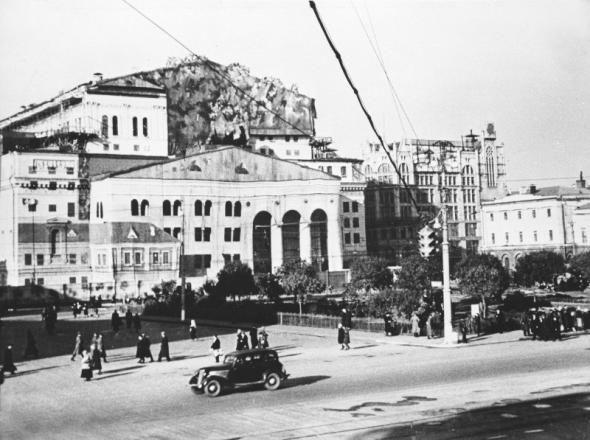
Masking the Bolshoi Theatre

Hits in the remaining capital
Of course, most of the credit in the reflection of the Nazi air raids belongs brilliantly organized air defense. From 8600 bombers sent to the Soviet capital, goals reached less than three percent, and in 1392 the aircraft were destroyed fighters and anti-aircraft guns. Yet, 234 bombers could break through to Moscow and reset 1610 high-explosive bombs and incendiary about 100 thousand. Here also helped disguise: about a third of this deadly cargo hit the decoys. For the first nine months of bombing - from July 1941 to April 1942 - suffered only 19 small businesses, as well as 227 buildings (houses, hospitals, schools, theaters). If not plan Iofana, destruction would be many times more. During the war, Moscow was bombed 141 times, of which the Kremlin - eight, and that does not cause significant damage.
However, in 1945 at the Kremlin commandant's a serious problem, how to make gold-domed Moscow again, after four years of paint ingrained in the dome. But the Victory Parade was held in Moscow hardly affected.
--img7--
Parade on Red Square November 7, 1941
--img8--
Source: tainy.info
The Germans invaded the Soviet state on June 22. It was clear that very soon the clouds of enemy bombers to take off to Moscow, but because by the middle of July, Moscow was surrounded by a dense ring of defense and led the embattled aircraft. Despite this, the command understood that 100 percent against air attack will fail: some aircraft still break through to the capital. Prepared to protect the public bomb shelters, provided blackout buildings and transport. But what about the important strategic objects, plants, architectural monuments, as well as the Mausoleum and the Kremlin - a symbol of the country? How to prevent their destruction?
Exit found a group of architects led by Boris Mikhailovich Iofana. He suggested that simply mask the Kremlin, the surrounding area, and the rest of the most valuable objects. The project at the time looked fantastic! But there was no time to reflect - the troops of Army Group "Center" rushed to Moscow, and the command had to agree. The archive remained secret memo dated 26 June 1941, in which the Kremlin commandant, Major-General Nikolai Spiridonov recommends Laurentia Beria immediately implement the plan Boris Iofana.

Walls and towers disguised as homes
Moscow does not Zlatoglavaya
Talking about the disguise of the Kremlin, could not help remembering an old anecdote: "As long as the enemy is developing a strategy offensive, Soviet soldiers manually alter the landscape and thus introduced the enemy into confusion." This is what our soldiers do. Drafting group Iofana completed by July 14. Offers two versions of the "disappearance" of the Kremlin: plane and false disguise. The first involves repainting buildings and hide their most noticeable elements. Muscovites immediately went to work: all the old buildings stylized as ordinary houses, painted over green roofs, caused the dark paint on the gilded domes, crosses removed, sheathed stars on the towers. On the Kremlin walls painted windows and doors, and teeth covered with plywood, imitated rooftops. All this is carried out by specially selected from each shelf unit. At the highest buildings such as Ivan the Great Bell worked climbers. During repainting particularly important and valuable structures necessarily present architects.
In the second variant masking needed using false objects unrecognizable to change the layout of the Moscow streets. Throughout Moscow, and especially in the vicinity of the Kremlin, the building appeared ghost who "built up" all the squares and parks. Silhouettes of many structures have changed scrim. Everywhere stretched to not existing roads, but the real painted so as to be visible from above "roofs". So from the air looked, and Red Square. And across the Moscow River bridge spread false.
By the way, despite the fact that the mausoleum became too "ordinary city building" - it has grown over the plywood two-storey house - to completely destroy the resting place of Lenin, it was enough to hit a bomb. And because July 3, Lenin's body was sent by special train to Tyumen. Back Ilyich returned only 28 March 1945.

BM Lofan. His plan masking saved Moscow from destruction

The first raid
Finish to disguise the bombing did not have time. The first attack occurred on the night of 21 July 22 - exactly one month after the war began. Around 10 pm 220 Luftwaffe (German Air Force) appeared from Smolensk. Piloted their professional pilots gain experience breaking through the defense even during the bombing of cities in Western Europe. However, to get through to Moscow was much more difficult - through Soviet antiaircraft barrier managed to get only a few machines. The fact that the disguise worked, says such a fact: the territory of the Kremlin dropped a few bombs, and do not cause serious damage. Only one 250-pound bomb landed in the Grand Kremlin Palace - the bomb pierced the roof and the ceiling of St. George Hall, hit the floor, but did not explode. All in all, in Moscow during this five-hour raid 37 buildings collapsed.
Convinced of the effectiveness of the plan Iofana, command tried as quickly as possible to complete the disguise. Already on July 29 MGB Major NS Bacon soared over Moscow by plane "Douglas" and inspection activities from a height of a thousand meters, was pleased with the result.

Blind-Fight
Starting from July 22, the bombing became regular. Nazi planes appeared over Moscow, barely dusk falls, and bombed until five or six o'clock in the morning. Sometimes overnight happened four or five raids. Due to the powerful defense Germans did not dare to attack the daytime, and at night "rebuilt" Moscow shoot them down completely confused. Bombers usually move in two waves: the first threw firebombs, and the second - explosive, aiming at the first object illuminated. It is clear that with such a sight difficult to determine where the real purpose, and where not. Of course, the pilots have adapted to distinguish some dummies (for example, painted houses, as opposed to the real, do not cast shadows). But stray flares specifically established for this small-caliber anti-aircraft guns and machine guns, blinded pilot beams of searchlights, had to dive under heavy anti-aircraft fire, which made air attacks even harder. So most of the bombs were dropped randomly, and many sights strikes by "ghosts." For example, some false objects Muscovites specifically highlighted, creating the effect of impaired blackout, and German bombs flew it there.

Masking the Bolshoi Theatre

Hits in the remaining capital
Of course, most of the credit in the reflection of the Nazi air raids belongs brilliantly organized air defense. From 8600 bombers sent to the Soviet capital, goals reached less than three percent, and in 1392 the aircraft were destroyed fighters and anti-aircraft guns. Yet, 234 bombers could break through to Moscow and reset 1610 high-explosive bombs and incendiary about 100 thousand. Here also helped disguise: about a third of this deadly cargo hit the decoys. For the first nine months of bombing - from July 1941 to April 1942 - suffered only 19 small businesses, as well as 227 buildings (houses, hospitals, schools, theaters). If not plan Iofana, destruction would be many times more. During the war, Moscow was bombed 141 times, of which the Kremlin - eight, and that does not cause significant damage.
However, in 1945 at the Kremlin commandant's a serious problem, how to make gold-domed Moscow again, after four years of paint ingrained in the dome. But the Victory Parade was held in Moscow hardly affected.
--img7--
Parade on Red Square November 7, 1941
--img8--
Source: tainy.info


